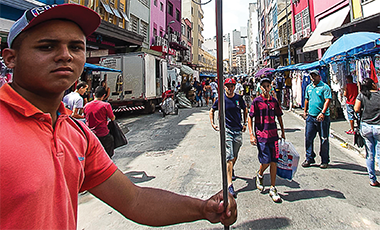The following post by IFPRI Director General, Shenggen Fan, was originally published in the Huffington Post.
If you were tasked to end hunger and malnutrition in the world, you might first ask: Where do such vulnerable people live? It may be a surprise that the majority of the world’s hungry and malnourished live in large Middle Income Countries (MICs), some of which are global economic powerhouses. These countries are hosts to the Missing Middle, or vulnerable populations that tend not to either benefit from or contribute to the rapid economic growth that is characteristic of their countries.
To shine a spotlight on this issue, I co-wrote a chapter on the urgent need to find solutions for the Missing Middle in the 2014-2015 Global Food Policy Report with Ertharin Cousin, Executive Director of the World Food Programme. We focused on five MICs: Brazil, China, India, Indonesia, and Mexico which, despite their impressive progress in reducing poverty, hunger, and malnutrition, are still home to 363 million hungry people.
Further, undernutrition remains a problem in these countries: about half the children in India and one-third in Indonesia are stunted, and Mexico and China have yet to eliminate undernutrition. And alarmingly, overweight and obesity are on the rise in China, India, and Indonesia. In Mexico and Brazil, the alarm has long since sounded, as the majority of adults are overweight. In Mexico, a third are obese.
I do not want to understate the great strides and concerted efforts these countries have made so far. Between 1990 and 2014, Brazil reduced hunger by almost two-thirds, and China and Indonesia by more than one-half. China and Brazil also greatly reduced child stunting in that time. Yet to really end poverty, hunger, and malnutrition for the poorest and most vulnerable, even more must be done.
To tackle hunger and malnutrition in MICs, we must first identify the underlying causes. In truth, MICs are very different from each other. But there are a few common characteristics that explain the persistence of hunger and malnutrition.
First, rising inequalities across wealth, gender, and access to education add to the burdens of hunger and malnutrition. Secondly, social safety nets in these countries, meant to protect the most vulnerable, are not as effective as they could be. Instead they are at times poorly targeted, and they persistently lack focus on nutrition. And lastly, demographic changes play a role: urbanization and changing consumer preferences have had vast implications for obesity and resource use, in part due to sedentary lifestyles alongside the proliferation of highly processed, sugary, salty, and fatty foods.
As countries that have exhibited impressive economic growth, MICs are in a unique position to address the underlying problems of hunger and malnutrition in their countries, as relatively few policy and budget commitments can translate to significant progress. There are no cookie-cutter solutions to ending hunger and malnutrition, but there are some common approaches that each country can take to continue in the right direction.
To reshape their food systems for better nutrition and health, MICs can, for example, increase incentives to produce, process, and market high-nutrient foods and reduce distorted incentives to produce just low-nutrient staples. Secondly, given the importance of gender equity in improving food security and nutrition, MICs should focus on reducing inequalities and empowering women, especially in agriculture.
Improving access to clean water, adequate sanitation, proper hygiene (WASH), and health clinics in rural areas can have a huge influence on reducing undernutrition, especially in India. MICs should provide effective social protection targeted to the poor to reduce hunger and malnutrition and promote inclusive growth. And as MICs make their way toward even better food security and nutrition, they should learn from each other and help to reduce hunger and malnutrition in other developing countries through knowledge, investments, and aid.
In the end, only MICs can find and roll out specific solutions to lift up the Missing Middle in their countries. The international community should support country-led solutions; it cannot realize its ambitious international agenda of achieving zero hunger and malnutrition without a renewed focus on the Missing Middle.







